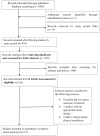Prevalence of human respiratory syncytial virus, parainfluenza and adenoviruses in East Africa Community partner states of Kenya, Tanzania, and Uganda: A systematic review and meta-analysis (2007-2020)
- PMID: 33905425
- PMCID: PMC8078816
- DOI: 10.1371/journal.pone.0249992
Prevalence of human respiratory syncytial virus, parainfluenza and adenoviruses in East Africa Community partner states of Kenya, Tanzania, and Uganda: A systematic review and meta-analysis (2007-2020)
Abstract
Background: Viruses are responsible for a large proportion of acute respiratory tract infections (ARTIs). Human influenza, parainfluenza, respiratory-syncytial-virus, and adenoviruses are among the leading cause of ARTIs. Epidemiological evidence of those respiratory viruses is limited in the East Africa Community (EAC) region. This review sought to identify the prevalence of respiratory syncytial virus, parainfluenza, and adenoviruses among cases of ARTI in the EAC from 2007 to 2020.
Methods: A literature search was conducted in Medline, Global Index Medicus, and the grey literature from public health institutions and programs in the EAC. Two independent reviewers performed data extraction. We used a random effects model to pool the prevalence estimate across studies. We assessed heterogeneity with the I2 statistic, and Cochran's Q test, and further we did subgroup analysis. This review was registered with PROSPERO under registration number CRD42018110186.
Results: A total of 12 studies met the eligibility criteria for the studies documented from 2007 to 2020. The overall pooled prevalence of adenoviruses was 13% (95% confidence interval [CI]: 6-21, N = 28829), respiratory syncytial virus 11% (95% CI: 7-15, N = 22627), and parainfluenza was 9% (95% CI: 7-11, N = 28363). Pooled prevalence of reported ARTIs, all ages, and locality varied in the included studies. Studies among participants with severe acute respiratory disease had a higher pooled prevalence of all the three viruses. Considerable heterogeneity was noted overall and in subgroup analysis.
Conclusion: Our findings indicate that human adenoviruses, respiratory syncytial virus and parainfluenza virus are prevalent in Kenya, Tanzania, and Uganda. These three respiratory viruses contribute substantially to ARTIs in the EAC, particularly among those with severe disease and those aged five and above.
Conflict of interest statement
The authors have declared that no competing interests exist.
Figures
Similar articles
-
Severe acute respiratory infection in children in a densely populated urban slum in Kenya, 2007-2011.BMC Infect Dis. 2015 Feb 25;15:95. doi: 10.1186/s12879-015-0827-x. BMC Infect Dis. 2015. PMID: 25879805 Free PMC article.
-
Prevalence of human respiratory syncytial virus infection in people with acute respiratory tract infections in Africa: A systematic review and meta-analysis.Influenza Other Respir Viruses. 2018 Nov;12(6):793-803. doi: 10.1111/irv.12584. Epub 2018 Jul 5. Influenza Other Respir Viruses. 2018. PMID: 29908103 Free PMC article.
-
Detection of influenza, parainfluenza, adenovirus and respiratory syncytial virus during asthma attacks in children older than 2 years old.Allergol Immunopathol (Madr). 2003 Nov-Dec;31(6):311-7. doi: 10.1016/s0301-0546(03)79204-0. Allergol Immunopathol (Madr). 2003. PMID: 14670285
-
Contribution of respiratory syncytial virus, influenza and parainfluenza viruses to acute respiratory infections in San Luis Potosí, Mexico.Pediatr Infect Dis J. 2005 Dec;24(12):1049-52. doi: 10.1097/01.inf.0000190026.58557.93. Pediatr Infect Dis J. 2005. PMID: 16371864
-
Global patterns in monthly activity of influenza virus, respiratory syncytial virus, parainfluenza virus, and metapneumovirus: a systematic analysis.Lancet Glob Health. 2019 Aug;7(8):e1031-e1045. doi: 10.1016/S2214-109X(19)30264-5. Lancet Glob Health. 2019. PMID: 31303294
Cited by
-
Impact of Nonpharmaceutical Interventions during the COVID-19 Pandemic on the Prevalence of Respiratory Syncytial Virus in Hospitalized Children with Lower Respiratory Tract Infections: A Systematic Review and Meta-Analysis.Viruses. 2024 Mar 11;16(3):429. doi: 10.3390/v16030429. Viruses. 2024. PMID: 38543794 Free PMC article.
-
Profiles of viral pathogens from individuals with acute respiratory tract infections in northern Tanzania.IJID Reg. 2025 Jun 13;16:100686. doi: 10.1016/j.ijregi.2025.100686. eCollection 2025 Sep. IJID Reg. 2025. PMID: 40688525 Free PMC article.
-
Prevalence of Respiratory Syncytial Virus Among Children Under 5 Years of Age in Sub-Saharan Africa.Glob Pediatr Health. 2024 Nov 17;11:2333794X241298803. doi: 10.1177/2333794X241298803. eCollection 2024. Glob Pediatr Health. 2024. PMID: 39559718 Free PMC article. Review.
-
SARS-CoV-2 co-detection with influenza and human respiratory syncytial virus in Ethiopia: Findings from the severe acute respiratory illness (SARI) and influenza-like illness (ILI) sentinel surveillance, January 01, 2021, to June 30, 2022.PLOS Glob Public Health. 2024 Apr 18;4(4):e0003093. doi: 10.1371/journal.pgph.0003093. eCollection 2024. PLOS Glob Public Health. 2024. PMID: 38635749 Free PMC article.
-
Severe lower respiratory tract infections are associated with human adenovirus in hospitalised children in a high HIV prevalence area.Afr J Thorac Crit Care Med. 2024 Jul 4;30(2):e1208. doi: 10.7196/AJTCCM.2024.v30i2.1208. eCollection 2024. Afr J Thorac Crit Care Med. 2024. PMID: 39171152 Free PMC article.
References
-
- WHO | Battle against Respiratory Viruses (BRaVe) initiative [Internet]. WHO. [cited 2018 Mar 5]. http://www.who.int/influenza/patient_care/clinical/brave/en/
Publication types
MeSH terms
LinkOut - more resources
Full Text Sources
Medical
Miscellaneous






